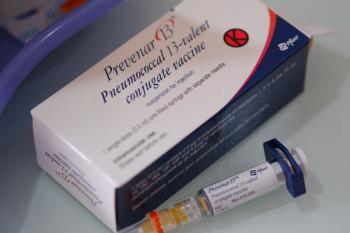
Becoming a one-stop shop for respiratory illness testing
When it comes to respiratory illness, patients want to get tested, get prescriptions, get comfort medicines — and get back to bed. Joseph Mann, MSN, FNP-C, joins Drug Topics® to discuss how you can become a one-stop shop built on the power of digitally read, rapid antigen testing platform.
Drug Topics®: Hi Joe. Thanks so much for joining us again today. I am going to kick things over to you and we can get started with an introduction.
Joseph Mann: Hey everyone. My name is Joseph Mann. I'm a family nurse practitioner by training. I work for Becton Dickinson in our point-of-care SARS-CoV-2 diagnostics, as a global medical science liaison. I've been supporting our COVID-19 tests for about 2 years now.
Drug Topics®: The CDC announced that they were streamlining the guidance around COVID-19. How has the streamlined guidance impacted COVID-19 testing in the pharmacy?
Mann: Great question. I think the main takeaway I personally have from the CDCs recent announcement and relaxation on their guidance was that they're really stepping back and putting the responsibility of testing and management of COVID-19 on all of us as individuals. While that's certainly a positive and encouraging sign that they feel comfortable to do this, it also raises a lot of questions right on how the American people will manage COVID-19 themselves moving forward. Will everyone take this responsibility seriously and get vaccinated and boosted for COVID-19 and flu? Will they continue to test themselves when they have symptoms? Wear masks when indoors or in congregated settings like airports and buses and things like that during the holiday season? So, a lot remains to be seen on this front. With respect to how this will affect pharmacy specifically, and we've discussed this before Lauren, but I really believe pharmacies are in a unique position to be a convenient one stop shop for COVID-19 and flu testing, especially during these cold fall and winter months. A you now know, depending on state laws, pharmacists can test and even prescribe antiviral medications like Tamiflu and Paxlovid for patients that test positive. That's obviously extremely convenient for patients because most of us know how it feels when we come down with COVID-19 or the flu, it's awful. We just want to lay down there in bed and sleep it off. The last thing we want to do is wait 2 hours to be seen at the doctor's office only to be given a prescription and then wait in line for another couple hours at the pharmacy for them to fill our medications. That's really unfortunate, especially with respect to these antiviral medications, because the medications are proven to cut down on the number of days that we feel sick and reduce our risk of requiring hospitalization. Imagine if you could get tested, get your prescriptions, and get any other comfort medicines you need like Dayquil and Tylenol that are available in pharmacies and then just go home. It would be so much easier and convenient. This is why rapid point-of-care tests like our BD Veritor system, which has tests for flu, COVID-19, RSV, and group A strep could be so beneficial for pharmacies to have throughout this flu season.
Drug Topics®: That's a really great point that I hadn't thought of. You have to go the doctor or urgent care, wait there and you already feel awful, and then you have to go to the pharmacy. I'm really lucky. My pharmacy delivers so I've like never had to do that, but that is a really, really good point. I hope people kind of internalize that pharmacists being able to test, and treat is really important. As we head in the cold and flu season, do you anticipate that there's going to be an increased demand for either point-of-care or at-home COVID-19 tests? If so, how can pharmacists prepare themselves for this demand?
Mann: I do think there will be an increased demand for point-of-care and at-home COVID-19 testing, as we head into these winter months. We're already beginning to observe an exponential rise in the number of flu cases reported in the United States by the CDC. Average reported flu cases were over 5 times higher than where they were in August already. We've seen in other parts of the world, for instance Australia, they've experienced a twindemic, where COVID-19 and flu cases surged at the same time, back in June, during their flu season. Australia flu cases were reported actually to be higher than the 5-year national average. Unfortunately, this occurred along with a surge of infections from the highly infectious Omicron BA.5 subvariant. We don't know what variants may be in store for us throughout our flu season. Hopefully, nothing comes of that but it's always a possibility. I will say what happens in Australia isn't necessarily a direct indicator of what's going to happen here, in the United States. Obviously, there are a lot of factors to consider here like: how many people will get vaccinated and boosted, how many people will be testing themselves, how many people will be practicing those social distancing measures and mask wearing. All of those factors will play a significant role in what this flu season has in store for us. But given what we've seen in other parts of the world and the relaxed measures from the CDC, I think we're in a pretty precarious situation right now and we should be planning and preparing as much as we can.
Drug Topics®: That's definitely concerning, even from a nonpharmacist’s perspective, seeing those numbers on the rise. I think we all know vaccines are available. Boosters are available now. There's an Omicron-specific booster. Does an individual's vaccination status impact whether they should use an at-home test or a point-of-care test when they're experiencing COVID-19 symptoms?
Mann: Not at all and it really doesn't matter if you've received 1, 2, or no COVID-19 vaccines at all. Vaccination status doesn't determine whether or not you should use an at-home, or a point-of-care COVID-19 test. Quite frankly, most rapid at-home tests work the same exact way as rapid tests in the point-of-care setting or in your doctor's office. In most cases, you aren't receiving a better or more accurate rapid test at a doctor's office versus testing yourself at home. If you are experiencing symptoms though and your rapid at-home test was negative, it is possible for them to be falsely negative, meaning that the test reports a negative result when in actuality you're truly positive. Rapid tests used at home and in the point-of-care setting are slightly less accurate than those highly sensitive PCR tests that we see being performed at laboratories. So, if you're symptomatic and you're at-home tests was negative, you can either repeat with another at-home test in about 24 to 48 hours, just to be more confident your result was truly negative, or you could schedule an appointment with your health care provider. If your symptoms are really unbearable and you wanted to be 100% certain, you could, make an appointment with your health care provider and have them evaluate your symptoms to see if a confirmatory laboratory PCR test is warranted.
Drug Topics®: How can pharmacists start today to prepare their staff for the potential increase in patients who are seeking point-of care-testing for winter respiratory illnesses? So not necessarily COVID-19, but cold and flu?
Mann: Excellent question and at BD we completely recognize how busy the pharmacy world is. When I was a nurse practitioner working at the CVS MinuteClinic for instance, I always built very close working relationships with my pharmacist. I can tell you. Those people never sit down. They're always doing something, whether that is giving a vaccine, filling prescriptions, taking orders from a prescriber over the phone, answering patient questions. They're very busy people. First and foremost, I think efficiency and ease-of-use will be the most critical components of any point-of-care testing solution during this respiratory season, especially for pharmacists.
Because I'm most familiar with it, I'd like to speak briefly about our BD Veritor system and how I believe it could help pharmacists prepare for increased point-of-care testing demand this flu season. Our BD Veritor system is a digitally read, rapid antigen testing platform with several different assays, which I mentioned earlier. These include flu, RSV, COVID-19, and group A strep. More recently, we authorized a combined COVID-19 and flu assay, which tests for influenza A, influenza B, and COVID-19 from 1 patient swab. It gives results for these 3 targets in 15 minutes. It's very, very simple to perform.
Depending on the assay that you're testing, and I'll speak more specifically to the combined COVID-19 and flu test given our topic of conversation, the pharmacist typically collects a painless, superficial nasal swab specimen. It's not a deep or uncomfortable swabbing experience at all. Once the specimen is collected, the pharmacist then applies that swab to an extraction reagent. They mix it around for about 15 seconds. Then they can throw out the swab and essentially put a top on top of the extraction reagent. You instill 3 drops into the well of the test cartridge. You just wait 15 minutes for the test to process. It's extremely fast. Once that 15-minute time period is up, the cartridge can be plugged into the BD Veritor System Analyzer, which is about the size of the palm of my hand. It's very portable and very appropriate for a pharmacy setting where there's limited counterspace. The small portability features of the analyzer are pretty important. Then plug that cartridge into the analyzer and you get results almost instantly. You get a very clear positive or negative result interpretation from the analyzer. It's really simple. It's easy. It's fast. It's reliable.
We even have an additional application called ImageMover that can assist pharmacies to automate patient registration for testing and result communication. We realize pharmacists don't have the time to register patients for testing or communicate those results over the phone with patients. The ImageMover app allows the pharmacist to input the result digitally and automatically send an email to the patient, letting them know if they were positive or negative, so they don't have to spend time on the phone. We do everything we can to try and make this as simple and easy as possible for pharmacists, in particular.
Drug Topics®: That's awesome. I think the way that it streamlines the workflow is just incredible and super important. Those were all of the questions that I had. I did want to give you an opportunity. Are there any final thoughts or key takeaways that we haven't touched on in our discussion of COVID-19 and flu testing that you'd like to address?
Mann: I think I'll just reiterate a couple of points I made earlier about the importance of testing and vaccination this flu season because pharmacies have the capability to do both. If nothing else, I believe these 2 interventions are the most important tools that are available to us to fight this flu season. We should all be preparing and taking a proactive approach now in the beginning of flu season, before December, January, and February when we typically see most flu cases start to crop up. Those spikes in cases tend to occur in that time period. Everyone should be keeping a few at-home COVID-19 tests in their medicine cabinet and getting vaccinated and boosted as soon as possible. That would be my main takeaway message. I appreciate you giving me your time. It was a great discussion.
Drug Topics®: Thank you so much for joining us. And thank you for the reminder that I need to get both my flu vaccine and my COVID-19 booster. This was a great conversation. As always, I learned a lot. I'm sure our viewers will as well. Thank you.
Newsletter
Pharmacy practice is always changing. Stay ahead of the curve with the Drug Topics newsletter and get the latest drug information, industry trends, and patient care tips.





























































































































